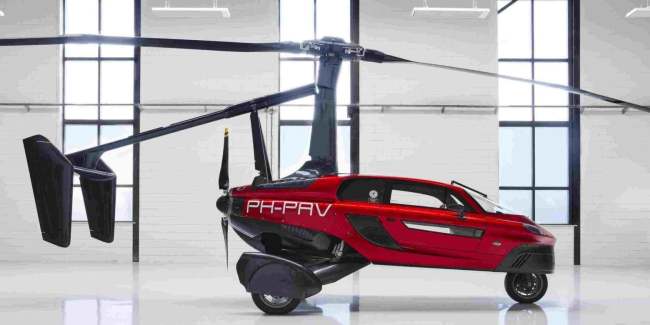Automobiles
[CES 2019] Back to the future with ‘flying cars’ on horizon
[THE INVESTOR] LAS VEGAS -- When it comes to future mobility, autonomous vehicles typically take the spotlight, as global automakers and tech companies compete to bring self-driving cars into the mainstream.
Further stretching the limits of transport, another mobility technology, once considered the realm of science fiction, is inching closer to reality: “flying cars.”
 |
A number of flying car prototypes and designs will be featured at the Consumer Electronics Show in Las Vegas that kicks off on Jan. 8. Airborne vehicles were a hot topic of interest at the CES “Future Mobility” track sessions held prior to the show’s official launch.
At CES 2019, automakers and startups will provide the public a glimpse of what flying cars will look and feel like, with many car-drone hybrids.
One such firm is Netherlands-based Pal-V, which is offering CES visitors a chance to experience a “virtual flight” in what it claims is the world’s first-ever commercial flying car -- the Pal-V Liberty.
According to the Dutch company, the vehicle passed a drive and flight test program in 2012 to prove that the Pal-V Liberty is technically feasible and certifiable within the existing regulatory framework. It is currently receiving reservations for the Pal-V Liberty limited editions.
“The challenge has always been to develop a commercially viable flying car not simply a futuristic concept,” Pal-V CEO Robert Dingemanse said in a statement. “The journey is much more challenging than simply designing a flying car since the regulatory framework demands safety of each and every manufacturer.”
Similarly, NFT, an aviation technology startup based in Israel and California, is developing a “fly and drive” vehicle with electric propulsion and an extended range generator that can take off and land vertically. It also has a booth at the trade show.
In building its flying car model, NFT is designing both hardware and software solutions while partnering with original equipment manufacturers to mass produce its vehicles.
Globally, many big and small companies are pursuing the development of flying cars. They include global ridesharing giant Uber Technologies, aircraft makers Airbus and Boeing as well as China’s Terrafugia. Opener and KittyHawk are also high-profile flying car startups backed by Google co-founder Larry Page.
But what’s the difference between a helicopter and a flying car? The biggest difference is that airborne cars are quieter and would not require a helipad to land, making them far more usable in real life.
When can we start flying in cars?
Does this mean we’re going to be seeing flying cars zipping around the skies in the near future?
For now, probably not, according to mobility experts at CES who emphasized the vast amount of regulatory and technical coordination that is needed to ensure the safety, efficiency and affordability of flying cars. But the technology is definitely a “next” in future mobility that will eventually happen down the road, they said.
 |
According to Thomas Prevot, director of engineering and aerospace systems at Uber, scalability and safety are issues that must be fully addressed before flying cars can go commercial.
“The key to viability is actually operating on a real scale, and making (flying cars) accessible and affordable to anyone. Or else it won’t relieve any kind of congestion (on the roads, as is hoped),” he said during a CES-hosted discussion on future mobility.
The US ride-hailing giant is currently pursuing a flying car project dubbed Elevate, with aims to launch a pilot electric air taxi service by 2020 and begin commercial operations in 2023.
Under the envisioned service, Uber’s air taxis would pick up and drop off passengers at designated roofs of buildings, opening a new era of mobility for urban commuters.
While the relevant technology may be nearing completion, building the appropriate ecosystem for flying cars will take some time as a system of uninterrupted communication between aviation regulators, drivers and sensors on airborne vehicles must be achieved before anything can go commercial, he noted.
“It’s a large network on which all these vehicles are operating. It’s a very complex orchestration act to make sure that the vehicles and pilot are all in the right places, charging stations are adequately located, and riders are matched properly,” the Uber executive said.
A system of cooperative surveillance is also critical to making projects like Uber’s viable, noted David Rottblatt, director of business development at EmbraerX, a Brazilian aircraft developer currently working with Uber on flying cars.
“When we think about the paradigm of aircraft control, cities aren’t that used to seeing commercial operations on a scale that companies like Uber are expecting,” he said.
For instance, if a flying car is traveling between 60 and 600 meters above ground, this could have implications on how well radar can keep track of all vehicles in the air. Autonomous data sharing is another consideration, as the entry of flying cars into the airspace will create an unprecedented complexity in air traffic that must be carefully managed, he said.
On the bright side, there is already a stable infrastructure for airborne travel, such as routes for helicopters, that can be leveraged for flying cars as well. And for this reason, some say air taxis could become a reality sooner than is expected.
According to a recent report published by Deloitte, the introduction of flying cars and passenger drones will add an “entirely new dimension to an already complex landscape (in the urban mobility space).”
However, the amount of impact that flying cars will have on current mobility systems is yet to be seen, the report points out.
“For passenger drones and flying cars to be widely accepted, they would likely have to be both ubiquitous and as versatile as an automobile -- people should be able to fly the vehicle to a store or take it to the beach, and it should be able to cover longer distances safely,” it said.
By Sohn Ji-young/The Korea Herald (jys@heraldcorp.com)








